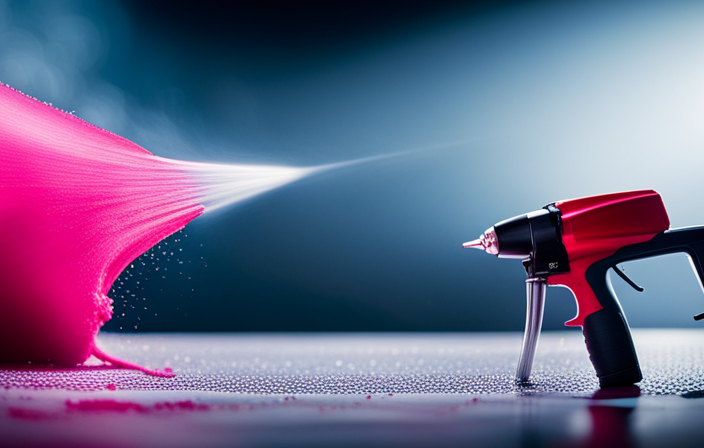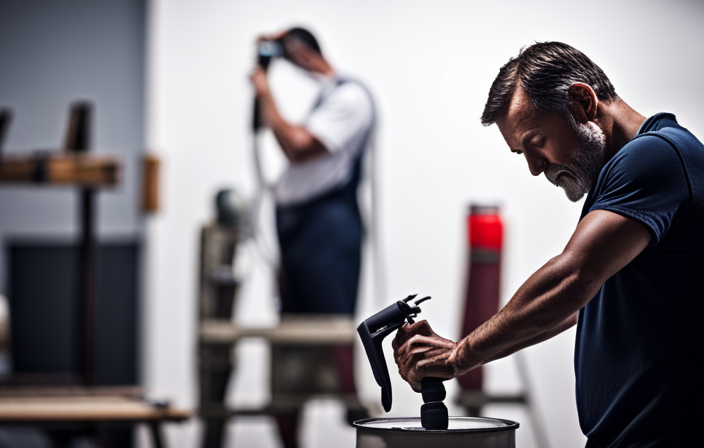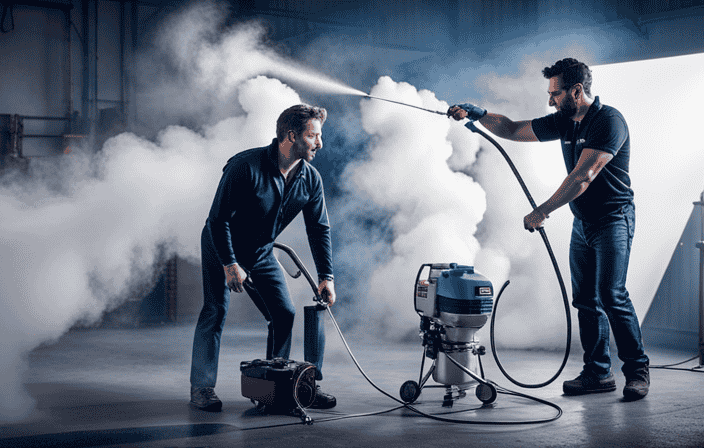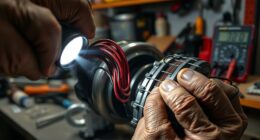Have you ever wondered if now is the right time to switch out the tip on your airless paint sprayer? No need to fret, I have all the information you need.
In this article, I’ll guide you through the process of determining whether or not you need a new tip for your sprayer. As someone who has had their fair share of experience with paint sprayers, I understand the importance of a well-functioning tip.
A worn-out or damaged tip can affect the quality of your paint job, resulting in uneven coverage and wasted paint. By learning to recognize the signs of wear and tear, checking for damage or deformation, and evaluating the tip’s performance, you’ll be able to make an informed decision about whether it’s time for a replacement.
So, let’s dive in and ensure that your next paint job is a smooth and efficient one.
Key Takeaways
- Signs of a worn-out tip include decreased paint flow, poor atomization, uneven spray patterns, clogs, and visible damage.
- Cleaning and maintaining the tip involves removing excess paint, soaking in a recommended solvent, gently scrubbing, rinsing with water, and drying completely before reattaching.
- Understanding different tip sizes is important, as it helps in choosing the appropriate tip size based on paint type, surface, spray patterns, and flow rates.
- Choosing the right tip for the project is crucial to achieve desired coverage and avoid issues like uneven coverage, overspray, and clogging.
Importance of a Well-Functioning Paint Sprayer Tip
If you want flawless paint results, you need to ensure your airless paint sprayer tip is working perfectly. Proper paint sprayer maintenance is essential for achieving professional-looking finishes.
To ensure your sprayer tip is functioning optimally, there are a few troubleshooting tips you can follow. First, check for any clogs or blockages in the tip by removing it and inspecting it closely. Clean the tip thoroughly using a cleaning solution or a small brush to remove any dried paint or debris.
Additionally, check for signs of wear and tear on the tip, such as a worn or frayed edge, as this can affect the quality of your paint application. By regularly inspecting and maintaining your sprayer tip, you can avoid uneven spray patterns and achieve the best results.
Signs of Wear and Tear on the Tip
When using an airless paint sprayer, it’s crucial to be aware of signs of wear and tear on the tip.
One of the key indicators is a decrease in paint coverage and an increase in overspray, which can result in wasted paint and an uneven finish.
Additionally, an uneven spray pattern may become evident, causing streaks or blotches on the painted surface.
Lastly, clogging and dripping can occur if the tip is worn, leading to interruptions in the painting process and a messy work area.
Decreased Paint Coverage and Overspray
To up your paint game and avoid any messy mishaps, check if your airless paint sprayer is leaving you with decreased coverage and excessive overspray, dude. These issues can indicate that the tip on your sprayer may need replacing. Here are some signs to look out for:
-
Uneven paint application: If you notice that the paint is not being evenly applied to the surface and there are areas with more or less coverage, it could be a sign of a worn-out tip.
-
Excessive overspray: If you’re experiencing a lot of overspray, where the paint is spraying beyond the intended area, it may be time to replace the tip.
-
Reduced efficiency: If you find that the sprayer is not as efficient as it used to be and you’re having to go over the same area multiple times to achieve the desired coverage, a new tip might be necessary.
-
Clogging issues: If the tip is frequently clogging, causing interruptions in the paint flow, it’s a clear indication that it needs to be replaced.
By addressing these issues and maintaining your paint sprayer properly, you can ensure a smooth and even spray pattern, which we’ll discuss in the next section.
Uneven Spray Pattern
To ensure a flawless finish on your surfaces, it is important to have a paint sprayer that delivers a smooth and even spray pattern. Evaluating spray quality is crucial in troubleshooting spray pattern issues. When using an airless paint sprayer, an uneven spray pattern can indicate a worn-out or damaged tip. To determine if you need a new tip, closely inspect the spray pattern for any inconsistencies, such as thicker or thinner areas. Uneven patterns can result in patchy coverage and an unprofessional look.
Additionally, check the tip itself for any signs of wear or damage, such as excessive wear on the edges or visible cracks. If you notice these issues, it’s time to replace the tip to ensure optimal performance.
Moving forward to the next section about ‘clogging and dripping,’ it’s important to address these issues promptly to maintain a smooth painting process.
Clogging and Dripping
Addressing clogging and dripping issues promptly will save you from frustrating paint mishaps. For example, when you’re trying to paint a smooth, flawless surface and suddenly your sprayer starts spewing globs of paint all over your carefully prepped walls.
To prevent clogging, it is crucial to clean your tip thoroughly after each use. Remove any dried paint or debris that may have accumulated. Additionally, using a filter will help catch any impurities that could clog the tip.
If you are still experiencing issues, try using a larger tip size or adjusting the pressure settings. Troubleshooting tip issues can be time-consuming but necessary for achieving a professional finish.
Now, let’s move on to checking for damage or deformation in the next section.
Checking for Damage or Deformation
Inspect your airless paint sprayer tip closely for any signs of damage or deformation to ensure optimal spraying performance. It is important to regularly evaluate your tip’s performance and maintain it properly to avoid any issues during the painting process. Here are some key areas to check for damage or deformation:
- Check for any cracks or breaks in the tip. Even a small crack can affect the spray pattern and result in uneven coverage.
- Look for any signs of wear or erosion on the tip. Over time, the tip can wear down, causing a decrease in performance.
- Examine the tip for any bent or misshapen parts. Any deformation can affect the spray pattern and result in drips or clogs.
Regularly inspecting your airless paint sprayer tip for damage or deformation is crucial for maintaining optimal spraying performance. By ensuring that your tip is in good condition, you can avoid any unnecessary issues and achieve a professional finish.
In the next section, we will discuss how to evaluate the tip’s performance.
Evaluating the Tip’s Performance
When evaluating the performance of the tip on my airless paint sprayer, I focus on three key factors: testing the fan pattern, assessing paint flow, and evaluating atomization.
To test the fan pattern, I spray a test surface and observe if the pattern is even and consistent.
Next, I assess the paint flow by checking if the paint is being dispensed smoothly without any interruptions or clogs.
Lastly, I evaluate the atomization by examining the quality of the paint particles being sprayed and ensuring they are fine and evenly distributed.
These three factors are crucial in determining the tip’s performance and whether it needs to be replaced.
Testing the Fan Pattern
To determine if you need a new tip on your airless paint sprayer, simply test the fan pattern and watch in awe as it effortlessly covers your surface with an explosion of color. Evaluating the spray pattern is crucial for troubleshooting tip issues. A well-functioning tip should produce a consistent and even fan-shaped spray pattern, ensuring efficient coverage and a professional finish. To assess the fan pattern, hold the sprayer at a distance from the surface and spray on a piece of cardboard or a test area. Observe the pattern formed by the paint. It should have a consistent width from top to bottom and should not have any irregularities or uneven areas. If you notice unevenness, tails, or excessive overspray, it may be an indication of a worn-out or clogged tip. In the next section, we will discuss assessing paint flow and atomization, which are also important factors to consider.
Assessing Paint Flow and Atomization
After testing the fan pattern of your airless paint sprayer, it is important to assess the paint flow and atomization to determine if you need a new tip.
Evaluating the spray pattern is crucial in troubleshooting spray gun issues.
To assess the paint flow, check if the paint is flowing smoothly and evenly from the tip. Any fluctuations or inconsistent flow may indicate a worn-out tip that needs to be replaced.
Additionally, pay attention to the atomization of the paint. Ideally, the paint particles should be fine and evenly distributed, creating a smooth and professional finish. If you notice any clumps or uneven spray, it could be a sign of a tip that is no longer performing optimally.
Considering the age and usage of the tip will help you make an informed decision about whether it’s time for a replacement.
Considering the Age and Usage of the Tip
If you’ve been using your airless paint sprayer for a while and notice that the tip has become worn down or has visible signs of damage, it’s probably time to consider getting a new one. Evaluating tip performance and troubleshooting tip issues is crucial in maintaining the efficiency of your sprayer. To help you determine if a new tip is needed, consider the age and usage of the current one. Over time, the tip can wear down, resulting in decreased paint flow and poor atomization. Additionally, excessive usage or exposure to harsh chemicals can cause tip damage, leading to uneven spray patterns and clogs. It’s important to regularly inspect your tip and replace it when necessary to ensure optimal performance. Cleaning and maintaining the tip is equally important in prolonging its lifespan and preventing costly repairs.
Cleaning and Maintaining the Tip
Regularly cleaning and maintaining the tip of your airless paint sprayer is like giving it a soothing spa treatment, ensuring smooth and flawless paint applications. To keep your sprayer tip in optimal condition, it is crucial to follow proper cleaning techniques.
Start by removing any excess paint from the tip using a clean cloth or brush. Then, soak the tip in a solvent recommended by the manufacturer to dissolve any dried paint residue. Use a small brush to gently scrub the tip, making sure to remove any clogs or debris.
Rinse the tip thoroughly with water and dry it completely before reattaching it to the sprayer. If you encounter any issues during the cleaning process, such as a stubborn clog, consult the troubleshooting tips provided in the manufacturer’s manual.
Understanding the different types of tips will be discussed in the subsequent section.
Understanding the Different Types of Tips
When it comes to choosing the right tip for your project, it’s important to consider factors such as the type of paint you’re using and the surface you’ll be spraying.
Different tips have different spray patterns and flow rates, so selecting the appropriate tip size can make a significant difference in the quality of your finish.
Knowing when to use different tip sizes is crucial for achieving the desired coverage and efficiency in your painting process.
Choosing the Right Tip for the Project
To ensure a flawless finish, it’s crucial to select the appropriate tip for your airless paint sprayer based on the specific project at hand. Choosing the right tip size for different paint types is essential.
For thinner paints, such as stains or lacquers, a smaller tip size like 0.009 to 0.013 inches is recommended. On the other hand, thicker paints like latex or enamels require a larger tip size, typically ranging from 0.015 to 0.021 inches.
It’s important to note that using the wrong tip size can result in uneven coverage, overspray, or clogging. Common mistakes to avoid when using an airless paint sprayer tip include using a tip that is too small for the paint thickness, not cleaning the tip properly, and not adjusting the pressure correctly.
Knowing when to use different tip sizes is crucial for achieving the best results with your airless paint sprayer.
Transitioning into the subsequent section, understanding the signs of a worn-out tip will help you determine when it’s time to replace it.
Knowing When to Use Different Tip Sizes
Knowing when to use different tip sizes is crucial for achieving optimal results with your airless paint sprayer. Using the wrong size can lead to issues such as uneven coverage, overspray, or clogging. It’s important to pay attention to the specific project you’re working on and choose the right tip size accordingly. Did you know that using the recommended tip size can increase your painting efficiency by up to 50%?
When it comes to different tip sizes, there are various materials to consider. Smaller tips are typically made of stainless steel, which provides excellent durability and resistance to corrosion. On the other hand, larger tips are often made of tungsten carbide, known for its superior wear resistance.
Using different tip sizes also offers advantages depending on the task at hand. Smaller tips are ideal for detailed work and fine finishes, while larger tips are more suitable for larger surfaces and thicker coatings. Additionally, using a narrower tip can help reduce overspray and improve control, while a wider tip allows for faster coverage.
Understanding the advantages of using different tip sizes will help you achieve the desired results for your project. Now, let’s explore the cost-effectiveness of replacing the tip.
The Cost-Effectiveness of Replacing the Tip
Figuring out if it’s time to get a new tip for your airless paint sprayer can actually save you some serious cash in the long run. Evaluating tip performance is crucial in determining whether it’s worth replacing.
If you notice a decrease in the quality of your spray pattern, such as uneven coverage or excessive overspray, it may be time for a new tip. Additionally, if you’re experiencing clogging or reduced flow, replacing the tip could greatly improve your efficiency.
However, before jumping to replace the tip, consider some tips for extending its lifespan. Regularly cleaning and maintaining your tip can help prevent clogs and ensure optimal performance. By being proactive in evaluating tip performance and taking steps to extend its lifespan, you can avoid unnecessary expenses and keep your airless paint sprayer running smoothly.
Now, let’s explore the steps for replacing the tip.
Steps for Replacing the Tip
When it comes to replacing the tip on my airless paint sprayer, there are two important steps that I need to follow:
-
Removing the old tip:
- First, make sure that the sprayer is turned off and the pressure is released.
- Use a wrench to loosen the tip and remove it from the sprayer.
-
Installing the new tip:
- Hand tighten the new tip into place.
- Make sure the new tip is secure.
By following these steps, I can ensure a smooth and successful replacement of the tip on my airless paint sprayer.
Removing the Old Tip
To remove the old tip on your airless paint sprayer, follow these steps:
-
Loosen the retaining nut with a wrench: It’s important to use the correct size wrench to ensure a secure grip on the nut. Using the wrong size can cause damage to the nut or the sprayer.
-
Turn the nut counterclockwise: To loosen the nut, turn it in a counterclockwise direction. Apply steady pressure while turning to avoid stripping the threads.
-
Remove the tip carefully: Once the nut is loose, carefully remove the old tip from the sprayer. Take note of any o-rings or gaskets that may be attached to the tip and ensure they are in good condition.
Now that you’ve successfully removed the old tip, let’s move on to installing the new one.
Installing the New Tip
Now that you’ve successfully removed the old tip, it’s time to move on to installing the new tip on your airless paint sprayer. This step is crucial for achieving optimal spray performance and ensuring an even coat of paint.
To begin, make sure the new tip is the correct size and type for your specific sprayer model. Then, hold the tip guard firmly and align the tip with the guard’s hole. Push the tip into the guard until it clicks into place. Give it a gentle tug to ensure it is securely attached.
If you encounter any issues during installation, such as difficulty aligning the tip or a loose fit, double-check the compatibility of the tip with your sprayer. Additionally, inspect the tip guard for any obstructions or damage that may hinder proper installation.
With the new tip securely installed, you can now move on to learning some valuable tips for prolonging the lifespan of your new tip.
Tips for Prolonging the Lifespan of Your New Tip
One way to ensure the longevity of your new tip is by following these tips for prolonging its lifespan and maintaining optimal performance. Here are some key strategies to consider:
| Tip #1 | Tip #2 | Tip #3 | Tip #4 | Tip #5 |
|---|---|---|---|---|
| Clean the tip thoroughly after each use to prevent clogs and buildup. | Store the tip in a clean and dry place to avoid corrosion. | Use the correct tip size for the job to prevent excessive wear. | Avoid spraying at extreme angles or distances to minimize tip wear. | Regularly inspect the tip for any signs of damage or wear and replace as needed. |
By implementing these practices, you can maximize the lifespan of your new tip and ensure that it consistently performs at its best. Remember, proper maintenance is essential for achieving optimal results with your airless paint sprayer.
Frequently Asked Questions
Can I use a damaged or worn-out tip on my airless paint sprayer?
Using a damaged or worn-out tip on your airless paint sprayer can lead to poor paint coverage and uneven application. Signs of a worn-out tip include decreased spray pattern, increased overspray, and inconsistent paint flow. Repair or replace the tip promptly for optimal performance.
How often should I clean and maintain the tip of my airless paint sprayer?
To prevent clogs in the tip of an airless paint sprayer and extend its lifespan, it is important to regularly clean and maintain the tip. This will ensure optimal performance and prevent any potential damage or wear.
Are there any specific cleaning solutions or methods I should use for cleaning the tip?
When it comes to cleaning tips for your airless paint sprayer, choosing the right cleaning solution is crucial. Opt for a cleaning solution specifically designed for paint sprayers to ensure efficient and effective removal of paint residues.
What are the different types of tips available for airless paint sprayers, and how do they differ in terms of performance?
There are several types of tips available for airless paint sprayers, including stainless steel, tungsten carbide, and ceramic. Stainless steel tips are durable and versatile, tungsten carbide tips offer superior wear resistance, and ceramic tips provide excellent finish quality but are more prone to damage.
Is it possible to repair a damaged or malfunctioning tip, or is replacement the only option?
Repairing or replacing a damaged or malfunctioning airless paint sprayer tip is crucial for optimal performance. Signs of a faulty tip include uneven spray patterns, clogs, or excessive overspray. Proper maintenance can extend the lifespan, but replacement is often the best option.
Conclusion
In conclusion, maintaining a well-functioning paint sprayer tip is crucial for achieving a smooth and professional finish.
By carefully inspecting for signs of wear and tear, checking for damage or deformation, and evaluating its performance, you can determine if a new tip is needed.
Understanding the different types of tips and considering their age and usage can also help in making an informed decision.
Replacing the tip, while cost-effective, ensures optimal performance.
Remember, taking steps to prolong the lifespan of your new tip will ensure a seamless painting experience.










